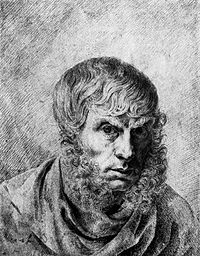

Caspar David Friedrich is considered the leader of German romantic painting, and the artist’s paintings are classic examples of this artistic direction. His landscapes bear the stamp of melancholy, seem mystical and unreal. Romanticism in Germany was primarily a literary trend and originated in the 1770s, thanks to the writings of the writers of the Storm and the Onslaught, who rejected the rational philosophy of the Enlightenment, advocating for an emotional, sensual perception of the world.
Caspar David Friedrich was born September 5, 1774 in the family of soap. The parents of the artist were orthodox Protestants, and their ten children grew up in an atmosphere of religious asceticism. When Caspar was seven years old, his mother died, and six years later one of his brothers died, saving Caspar himself, who fell through the ice during ice skating. Friedrich all his life blamed himself for his brother’s death. The upbringing and the succession of the tragedies experienced in childhood influenced the character of the artist, his tragic attitude, which resonated in the aesthetics of romanticism.
The melancholic and mystical landscapes of Kaspar Friedrich are filled with reflections about the brevity of human existence. He admires the amazing skill of the painter, his interest in the image of light, the sun’s rays, the reflection of waves, the artist’s paintings seem to be filled with an inner glow.
The textbook “Ages of Life” is a philosophical expression of the artist. Figures of people embody the stages of human life, the sea distance symbolizes non-existence, death. Closer to the coastline are the figures of children and two small ships, and in the distance, almost at the very horizon – a lonely sailboat, like a lonely standing old man in the foreground of the picture. The contemplative landscape motif acquires a deep symbolic sound, poetically telling about the life path of man.
Thanks to Friedrich’s friendship with the romantic poet VA Zhukovsky, his canvases reach Russia, where Nicholas I himself became interested in the artist and acquired several of his paintings.
After suffering a stroke in 1835, Kaspar Friedrich could no longer work fully, his fame died down and the artist himself was extinguished in poverty, living only on the donations of friends. In his paintings of this period, there are more and more symbols of death – crosses and owls. May 7, 1840, the great painter of the Romantic era was gone.